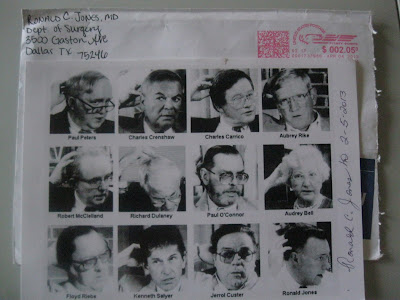Dr. Ronald Jones was one of the first doctors to see the president at Parkland Hospital.
He saw the neck wound before the tracheotomy was performed.
He says that the wound in the throat is consistent with an exit wound of a very low velocity missile.
Arlen Specter asked Dr. Jones if he saw any wounds. Dr Jones responded he saw a small wound in the neck no greater than a quarter inch in diameter.

Mr. SPECTER - Did you observe any wounds?
Dr. JONES - As we saw him the first time, we noticed that he had a small wound at the midline of the neck, just above the superasternal notch, and this was probably no greater than a quarter of an inch in greatest diameter, and that he had a large wound in the right posterior side of the head.
Mr. SPECTER - Will you describe as precisely as you can the wound that you observed in the throat?
 Dr. JONES - The wound in the throat was
probably no larger than a quarter of an inch in diameter. There appeared
to be no powder burn present, although this could have been masked by
the amount of blood that was on the head and neck, although there was no
obvious, amount of powder present. There appeared to be a very minimal
amount of disruption of interruption of the surrounding skin. There
appeared to be relatively smooth edges around the wound, and if this
occurred as a result of a missile, you would have probably thought it
was a missile of very low velocity and probably could have been
compatible with a bone fragment of either--probably exiting from the
neck, but it was a very small, smooth wound.
Dr. JONES - The wound in the throat was
probably no larger than a quarter of an inch in diameter. There appeared
to be no powder burn present, although this could have been masked by
the amount of blood that was on the head and neck, although there was no
obvious, amount of powder present. There appeared to be a very minimal
amount of disruption of interruption of the surrounding skin. There
appeared to be relatively smooth edges around the wound, and if this
occurred as a result of a missile, you would have probably thought it
was a missile of very low velocity and probably could have been
compatible with a bone fragment of either--probably exiting from the
neck, but it was a very small, smooth wound.Mr. SPECTER - In this report, Dr. Jones, you state the following, "Previously described severe skull and brain injury was noted as well as a small hole in anterior midline of the neck thought to be a bullet entrance wound. What led you to the thought that it was a bullet entrance wound, sir?
Dr. JONES - The hole was very small and relatively clean cut, as you would see in a bullet that is entering rather than exiting from a patient. If this were an exit wound, you would think that it exited at a very low velocity to produce no more damage than this had done, and if this were a missile of high velocity, you would expect more of an explosive type of exit wound, with more tissue destruction than this appeared to have on superficial examination.
Mr. SPECTER - Would it be consistent, then, with an exit wound, but of low velocity, as you put it?
Dr. JONES - Yes; of very low velocity to the point that you might think that this bullet barely made it through the soft tissues and just enough to drop out of the skin on the opposite side.
